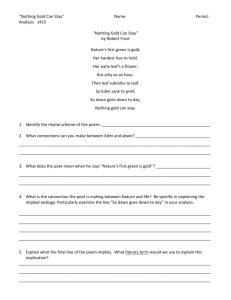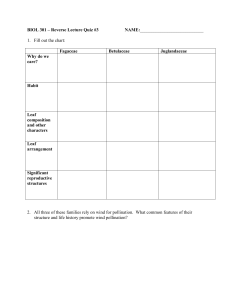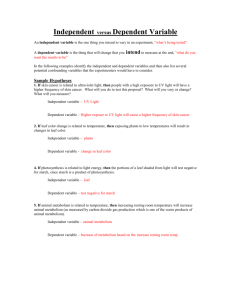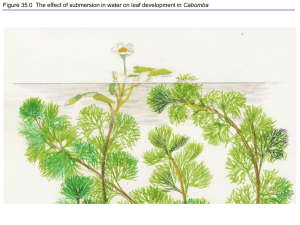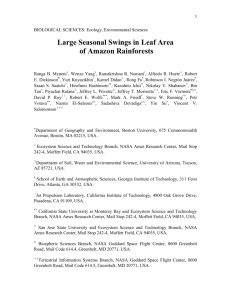L - J2e
advertisement
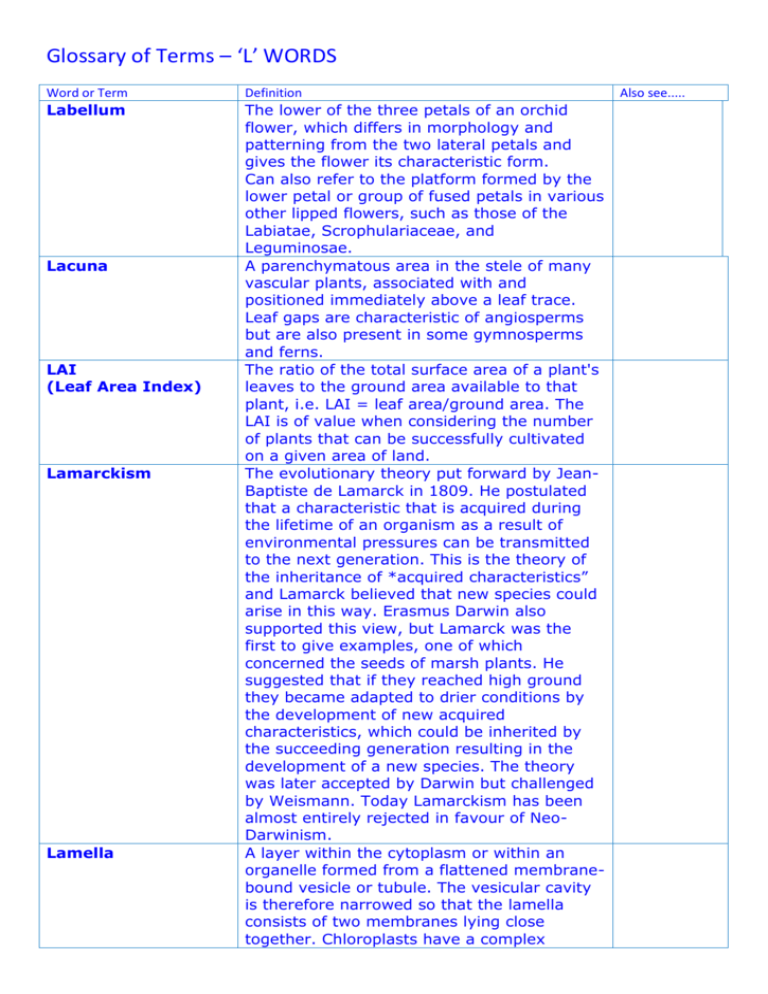
Glossary of Terms – ‘L’ WORDS Word or Term Definition Labellum The lower of the three petals of an orchid flower, which differs in morphology and patterning from the two lateral petals and gives the flower its characteristic form. Can also refer to the platform formed by the lower petal or group of fused petals in various other lipped flowers, such as those of the Labiatae, Scrophulariaceae, and Leguminosae. A parenchymatous area in the stele of many vascular plants, associated with and positioned immediately above a leaf trace. Leaf gaps are characteristic of angiosperms but are also present in some gymnosperms and ferns. The ratio of the total surface area of a plant's leaves to the ground area available to that plant, i.e. LAI = leaf area/ground area. The LAI is of value when considering the number of plants that can be successfully cultivated on a given area of land. The evolutionary theory put forward by JeanBaptiste de Lamarck in 1809. He postulated that a characteristic that is acquired during the lifetime of an organism as a result of environmental pressures can be transmitted to the next generation. This is the theory of the inheritance of *acquired characteristics” and Lamarck believed that new species could arise in this way. Erasmus Darwin also supported this view, but Lamarck was the first to give examples, one of which concerned the seeds of marsh plants. He suggested that if they reached high ground they became adapted to drier conditions by the development of new acquired characteristics, which could be inherited by the succeeding generation resulting in the development of a new species. The theory was later accepted by Darwin but challenged by Weismann. Today Lamarckism has been almost entirely rejected in favour of NeoDarwinism. A layer within the cytoplasm or within an organelle formed from a flattened membranebound vesicle or tubule. The vesicular cavity is therefore narrowed so that the lamella consists of two membranes lying close together. Chloroplasts have a complex Lacuna LAI (Leaf Area Index) Lamarckism Lamella Also see..... Lamina Lanceolate Landrace Latent infection Lateral root Layering LDP (Long-day plant) Leaching internal system of lamellae. The usually flattened blade-like portion of a leaf, as distinct from the petiole and leaf base. The shape of the lamina and the nature of its margin are important taxonomic character. Leaf laminas are usually the main photosynthetic organs and are structured accordingly. They are placed so as to make the best use of incoming light with the minimum amount of either overlapping or wasted space. This is particularly evident in a tree canopy. The pattern so achieved is termed the leaf mosaic and is mainly a result of phyllotaxis. Narrow and tapering at both ends. An ancient or primitive cultivar of a crop plant. Landraces are often genetically very heterogeneous and contain numerous alleles that contributed to the survival of the organism under natural conditions. Since intensive plant breeding can result in the loss of these alleles, landraces are a source from which plant breeders can selectively reintroduce them into highly bred cultivars. An infection in which no symptoms are visible during the first phase of the infection. Growth of the pathogen stops soon after penetration but resumes at some later stage Any root that originates endogenously from the pericycle of another root. A method of plant propagation involving the pegging down of runners and stolons to the soil surface. Adventitious roots develop where a node touches the soil and a shoot develops from the lateral meristem. New daughter plants eventually establish. Carnations are commonly propagated in this way. A plant that appears to require long days (i.e. days with more than a certain minimum length of daylight) before it will flower. In actual fact, it requires a daily cycle with no long dark periods. The washing out of soluble substances from the upper layers of the soil by water passing down the soil profile. The substances are either deposited lower down in the B horizon or removed completely. It takes place when the amount of rainfall exceeds the amount of water lost by surface evaporation. It may result in podsolization or the development of an impermeable layer of mineral salts at some point in the soil profile. Leaf Leaf buttress Leaf culture Lenticel Ligulate Limiting factor Linear Loam Lobed Loculicidal Lomentum The main photosynthetic organ of most green plants, consisting of a lateral outgrowth from a stem and comprising lamina , petiole , and leaf base. A lateral prominence on the shoot apex, destined to differentiate into a leaf. A form of tissue culture in which excised leaves, leaf material, or leaf primordia are grown on a sterile growth medium. A small elliptical pore containing loosely packed cells that is the means of gaseous exchange in the *periderm of plant axes. Lenticels are analogous to the stomata of primary tissues and vary in size from being almost microscopic to about 1 cm in length. Strap or tongue shaped as, for example, the outer ray florets of the inflorescences of plants in the family Compositae. A factor in the environment that by its presence or absence, or increase or decrease will govern the behaviour of an organism or a metabolic process within an organism. Most metabolic processes depend on more than one factor being present in order to proceed. When all other conditions are favourable, the factor nearest its minimum value is the limiting factor. For example, when a plant photosynthesizes on a warm sunny day in a moist environment, the amount of carbon dioxide available in the air will be the limiting factor. As evening approaches, light will become the limiting factor. Describing leaves, such as those of grasses, that are elongated and parallel sided for much of their length. A type of soil in which there is an even mixture of fine clay particles and coarser sand particles. It is the best type of soil for cultivation as the sand helps drainage and aeration but the clay prevents excessive water loss and binds the organic material. Describing a leaf that is divided into curved or rounded parts connected to each other by an undivided central area. Describing fruit dehiscence in which the slits in the pericarp arise along the dorsal suture of each carpel. A dry dehiscent fruit, developed from a single carpel, that contains one or more seeds. It resembles a *legume but on ripening false septa divide the pod into one-seeded units or valves that fracture at maturity. Such fruits Lumen are seen in sainfoin (Onobrychis viciifolia). A cavity enclosed by a cell wall, such as the centre of a xylem vessel.




